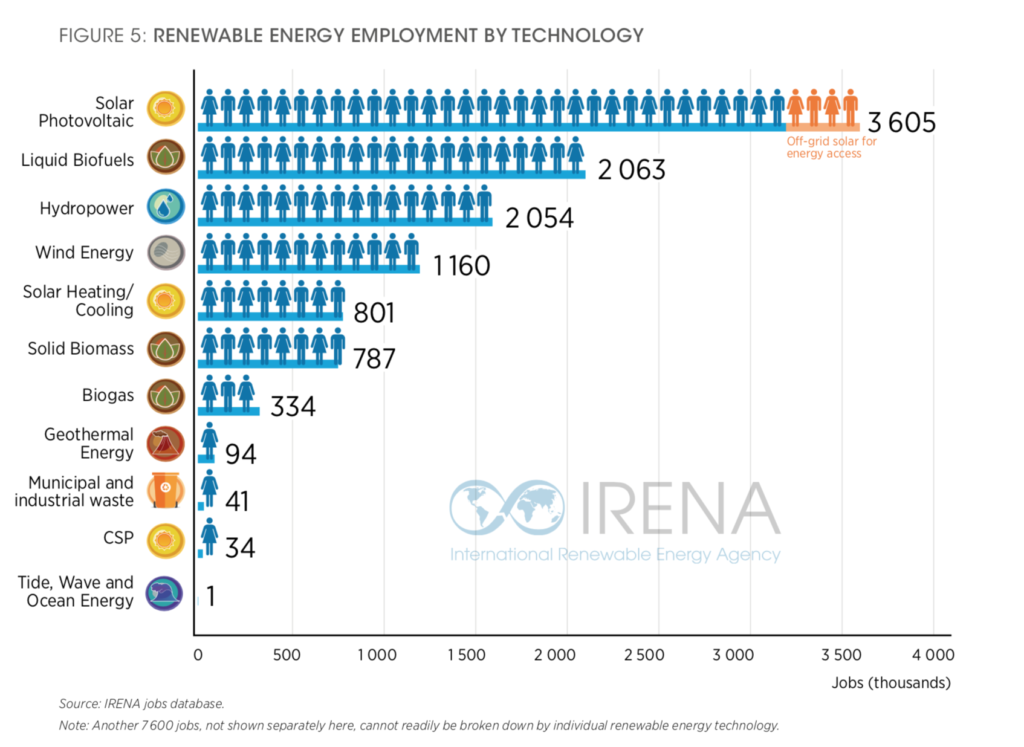The environmental credentials of renewables as drivers of a low carbon economy have long been touted as a solution to our current climate crisis. However, what is becoming increasingly evident is that they are also contributing significantly to overall global employment and hence socio-economic growth. Many governments are leaning towards domestic renewable energy choices so as to replace unsustainable fossil fuel based industries, with the sector continuing to grow year in year out. In fact, the renewable energy sector currently employs at least 11 million people worldwide (increasing from 10.2 million in 2017) and a growing number of countries are implementing policies and partaking in the business of manufacturing, trading and installing renewable energy technologies.
The majority of renewable energy jobs are concentrated in a handful of countries, namely China (with a whopping 39%), Brazil, the United States and a few members of the European Union. However, also due to the diverse geographic footprint of energy-generation capacities, employment in the sector in a number of different countries outside these major players is on an upward trend. Therefore, renewable energy is going hand-in-hand with development opportunities for industrialising countries, providing new forms of employment. Furthermore, renewable energy also increases off-grid energy access which can be extremely important in countries with less developed infrastructures. A great example can be found in sub-Saharan Africa where off-grid solar has already generated more than 100,000 full-time equivalent jobs whilst providing increased energy access.
The Alignment of Contributing Factors
The 2019 IRENA Renewable Energy and Jobs Report, highlights how the main contributing factors dictating the increased demand for labour are: governmental policies, including fiscal incentives and policy measures to promote the sector’s expansion; trade patterns; supply-chain diversification; and industry consolidation. When these factors align then the renewable energy sector grows and provides a wide variety of development and employment opportunities.
In terms of employment by renewable energy technology, the top driver in the sector remains Solar, with a 3.9 million workforce. This is particularly impressive due to the slowdown experienced in 2018 due to tariffs imposed by the Trump administration that led to a second consecutive year of drop in employment rates in the US. In 2018, the U.S. imposed duties of as much as 30% on solar equipment made abroad thus leading to a slowdown in their internal market. However, this is balanced out by continued growth in other parts of the globe and in particular by the booming Chinese solar market. In fact, the US’s influence in the sector is eclipsed by that of Asian countries in general, whereby out of the top 10 countries involved in the solar supply chain 8 are Asian, employing over 3 million people, with China alone giving work to over 2.2 million men and women.
Not Just Solar
However, it isn’t just about solar. Liquid biofuels are also large employers with an estimated 2 million people employed worldwide and a 6% increase from 2017. Followed closely by hydropower, that employs 2 million people and remains the renewable energy source with the highest installed capacity. Not to mention wind energy production, currently employing over 1.16 million people worldwide, although only growing by 1% since 2017.
Together these factors have led to an increase in quantity of jobs. However, when talking about sustainable development it is also important to address the quality of employment. Although it is hard to assess the overall impact of the renewable energy sector in terms of providing decent work (and therefore well paid, safe, rewarding and stable) what is certain is that skilled labour is in high demand, although job quality in the sector varies greatly across industries and companies. For example, the quality of work in the solar sector could vary greatly from that of the bioenergy sector; as the former requires less labour intensive and more technical labour, whereas the latter requires a significant amount of unskilled labour in the agricultural supply chain.
Inclusivity and Sustainability
Another aspect to consider is that of inclusion. In these terms the renewable energy sector is heading in the right direction. Current data indicates that 32% of the workforce is taken up by female personnel, decisively better than the oil and gas industry where women only make up 22% of the workforce. However, there are still disparities between male and female employment in the sector, including instances of wage disparity and unequal access to career advancement opportunities.
As we continue to move towards a global energy transformation the new dimension of employment in the renewable energy sector ensures socio-economic sustainability and therefore gives added incentives to commit to renewables. By focusing on providing decent and inclusive employment the renewable energy sector con not only contribute to overall employment levels, but also do so in a sustainable fashion.






